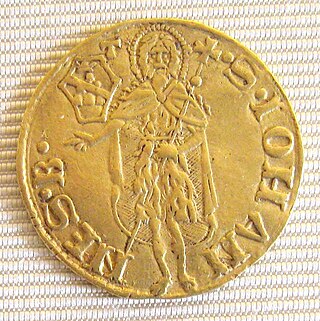
The Florentine florin was a gold coin struck from 1252 to 1533 with no significant change in its design or metal content standard during that time. It had 54 grains of nominally pure or 'fine' gold with a purchasing power difficult to estimate but ranging according to social grouping and perspective from approximately 140 to 1,000 modern US dollars. The name of the coin comes from the Giglio bottonato, the floral emblem of the city, which is represented at the head of the coin.

The lira was the currency of Italy between 1861 and 2002. It was introduced by the Napoleonic Kingdom of Italy in 1807 at par with the French franc, and was subsequently adopted by the different states that would eventually form the Kingdom of Italy in 1861. It was subdivided into 100 centesimi, which means "hundredths" or "cents". The lira was also the currency of the Albanian Kingdom from 1941 to 1943.
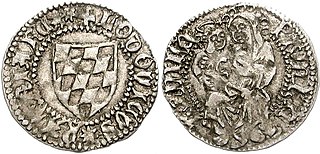
The soldo was an Italian medieval silver coin, issued for the first time in the late 12th century at Milan by Emperor Henry VI. The name derives from the late Roman coin solidus.

The scudo was the name for a number of coins used in various states in the Italian peninsula until the 19th century. The name, like that of the French écu and the Spanish and Portuguese escudo, was derived from the Latin scutum ("shield"). From the 16th century, the name was used in Italy for large silver coins. Sizes varied depending on the issuing country.
The florin was the currency of Lombardy-Venetia between 1862 and 1866.
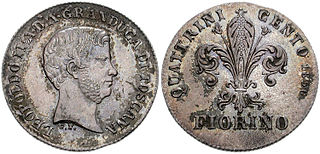
The Tuscan fiorino was the currency of Tuscany between 1826 and 1859. It was subdivided into 100 quattrini, a local currency made by four denari. There was an additional denomination called the paolo, worth 40 quattrini, in circulation.

The lira was the currency of the Grand Duchy of Tuscany until its annexation by Napoleonic France in 1807. After that year, it unofficially remained in circulation thanks to its silver value until the restoration of Tuscan independence in 1814. It was finally abolished in 1826.

The lira was the currency of the Papal States between 1866 and 1870. It was subdivided into 20 soldi, each of 5 centesimi.
The lira was the distinct currency of Venice until 1848, when it was replaced by the Italian lira. It originated from the Carolingian monetary system used in much of Western Europe since the 8th century CE, with the lira subdivided into 20 soldi, each of 12 denari.
The scudo was the currency of Milan until 1806. It was subdivided into 6 lire, each of 20 soldi or 240 denari.
The lira was the currency of the Republic of Lucca until 1800 and again of the Duchy of Lucca between 1826 and 1847. It was subdivided into 20 soldi, each of 3 quattrini or 12 denari.
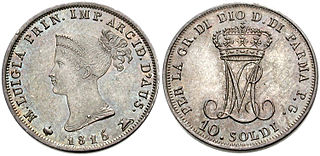
The lira was the distinct currency of Parma before 1802 and again from 1815 to 1859.

Cagliarese or callaresito is the name of a series of coins minted at Cagliari (Sardinia).

The Ticinese franco was the currency of the Swiss canton of Ticino between 1813 and 1850. It was subdivided into 20 soldi, each of 12 denari, similar to the British pounds, shillings and pence system. It was worth 1⁄4th the French silver écu or 6.67 g fine silver.
The Venetian grosso is a silver coin first introduced in Venice in 1193 under doge Enrico Dandolo. It originally weighed 2.18 grams, was composed of 98.5% pure silver, and was valued at 26 denarii. Its name is from the same root as groschen and the English groat, all deriving ultimately from the denaro grosso.
The scudo was the currency of the island Kingdom of Sardinia until 1816.

The scudo was the currency of the Piedmont and the other mainland parts of the Savoyard Kingdom of Sardinia until 1816.

Italy has a long history of different coinage types, which spans thousands of years. Italy has been influential at a coinage point of view: the medieval Florentine florin, one of the most used coinage types in European history and one of the most important coins in Western history, was struck in Florence in the 13th century, while the Venetian sequin, minted from 1284 to 1797, was the most prestigious gold coin in circulation in the commercial centers of the Mediterranean Sea.

The Coinage of the Republic of Venice include the coins produced by the Republic of Venice from the late 12th century to 1866. After this date, coins were still produced in Venice.
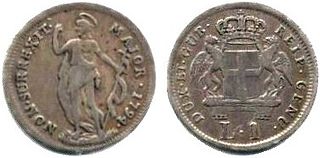
The Genoese lira was the currency of the Republic of Genoa until 1797.
This page is based on this
Wikipedia article Text is available under the
CC BY-SA 4.0 license; additional terms may apply.
Images, videos and audio are available under their respective licenses.
















